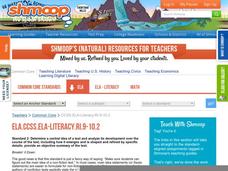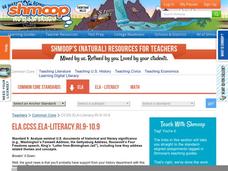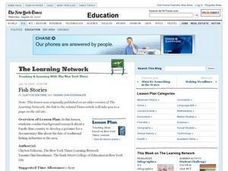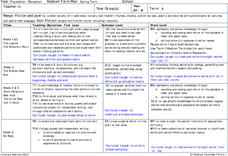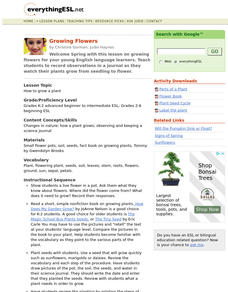Curated OER
Weather Proverbs
Define and write proverbs! Learners define proverbs, use the Internet to find weather-related proverbs, and talk with their parents to learn other proverbs. There's a well-structured worksheet included here.
Monterey Bay Aquarium
What's in a Name?
Combine art and word analysis in a lesson about genus and species. Elementary children sleuth out the meaning of scientific names for a number of shark species using a prefix and suffix definition chart. They then draw an image of the...
Curated OER
The Seven Continents Scavenger Hunt
Who doesn't enjoy an engaging scavenger hunt? Here, scholars listen to, and discuss, the informative text, Where is my Continent? by Robin Nelson. They then explore the seven continents and four major oceans using Google Earth.
Curated OER
Introducing Biographies - Getting to Know You
Learners explore several different types of biographies to determine their area of interest, choose one notable person they would like to explore, complete online tutorial on biographies, and use written and Internet resources to...
Curated OER
Cross-Curricular Language Arts Lessons
Here are lesson ideas to begin integrating social studies content into the language arts classroom.
National Book Network
A Day with No Crayons
Colors and crayons are the inspiration for this collection of activities! Kids illustrate the real world, come up with their own names for colors, make their own crayons (with teacher assistance), create artwork they can eat, and more.
Curated OER
Learning About Animals' Bodies
Students research different animals (mammals, reptiles, amphibians, insects, birds, fish) and create books, murals, dioramas, puppets, and sculptures to illustrate the necessity of various body parts for overall survival. In this animal...
Curated OER
Wild Animal Investigation - Habitat Diorama
Students research wild animals in cooperative groups and use their information to construct habitat dioramas. They demonstrate competence in using different information sources, including those of a technical nature, to accomplish...
Shmoop
ELA.CCSS.ELA-Literacy.W.9-10.9
Encourage your pupils to support their claims with textual evidence, whether is is from literary texts or informational texts. You might use the assignment example, which suggests an assignment on what it's like to be an immigrant in...
Schmoop
ELA.CCSS.ELA-Literacy.RI.9-10.2
Although the ideas on how to implement the skill RI.9-10.2 are lacking, the assessment would work well for challenging learners to summarize, and identify the main ideas of presidential speeches that are of similar topics. One could use...
Shmoop
ELA.CCSS.ELA-Literacy.RI.9-10.9
With a nice description of what the standard means, an idea for a class activity, and a quiz with answers, this resource should deepen your (and your pupils') understanding of the targeted Common Core standard. The provided activity is...
Curated OER
Highlights of Modern American Family Art and Literature
Students develop imagery in literary and art works. They discuss Jacob Lawrence's painting, the "Tombstones, 1942", which conveyed overcrowded tenements and families living in Harlem (New York, New York). They design picture stories...
Curated OER
Looking at Human Struggle Through The Language Arts Curriculum: The Faces of Slavery
Sixth graders examine the use of slavery in the United States. Using a map, they draw the route of the Tecora and Amistad voyages. Individually, they write an essay describing their opinions on whether the Africans on the ships should be...
Curated OER
Inventors & Trailblazers
Students are introduced to a groups of African American inventors. In groups, they research the role of each person in improving different industries. They also examine the barriers African Americans faced from the Civil War to the...
Curated OER
Soaring High with Kites
Learners make kites from patterns. They write haiku poetry. They listen to stories about kite festivals in different countries.
Curated OER
Meet Molly An American Girl
Students examine concepts of personal finance. In this personal finance lesson, students use Valerie Tripp's, Meet Molly, An American Girl, to learn about saving and spending after World War II. They compare financial decisions after...
Curated OER
First Lady Fashions
Sixth graders research and explore the fashion of a certain time while identifying with the personal convictions and tastes of the famous first ladies of the past. They practice what they explore adjectives to describe what they see and...
Curated OER
Fish Stories
Students conduct background research about a Pacific Rim country to develop a premise for a documentary film about the fate of traditional fishing industries in the area.
Curated OER
Aesop's Fables (Grade 3)
Third graders develop a presentation based on Aesop's Fables. In this Aesop Fables and presentation lesson, 3rd graders examine the characteristics of fables and how to interpret them. They choose one of Aesop's Fables to research. They...
Curated OER
Poetry Creations
Students produce iMovies to share their thoughts of friendship along with poetry creations in this technology-based lesson plan for the upper-elementary classroom. The lesson plan includes a link to a "create a poem" site and requires...
Curated OER
Fiction and Poetry
Pupils explore fictional text and poetry. They explore the story structures used in the types of texts and examine the language patterns used. Students practice tracking text in the correct manner.
Curated OER
Growing Flowers
Students grow flowers from seeds. They plant quick-growing seeds in a flower pot and consider what a seed needs to grow. They observe and record the growth of the planted seeds in science journals.
Curated OER
Science Talk about Mammals and Reptiles/Amphibians
Third graders use the internet to research mammals, reptiles and amphibians. They list important items about their chosen animal. Students identify characteristics of an animal and where they live. They classify animals as a mammal,...
Curated OER
Meet Molly, An American Girl
Students examine saving and spending decisions in 1944 through the eyes of Molly, a nine-year-old growing up during World War II. The lesson uses Meet Molly, An American Girl, by Valerie Tripp.











